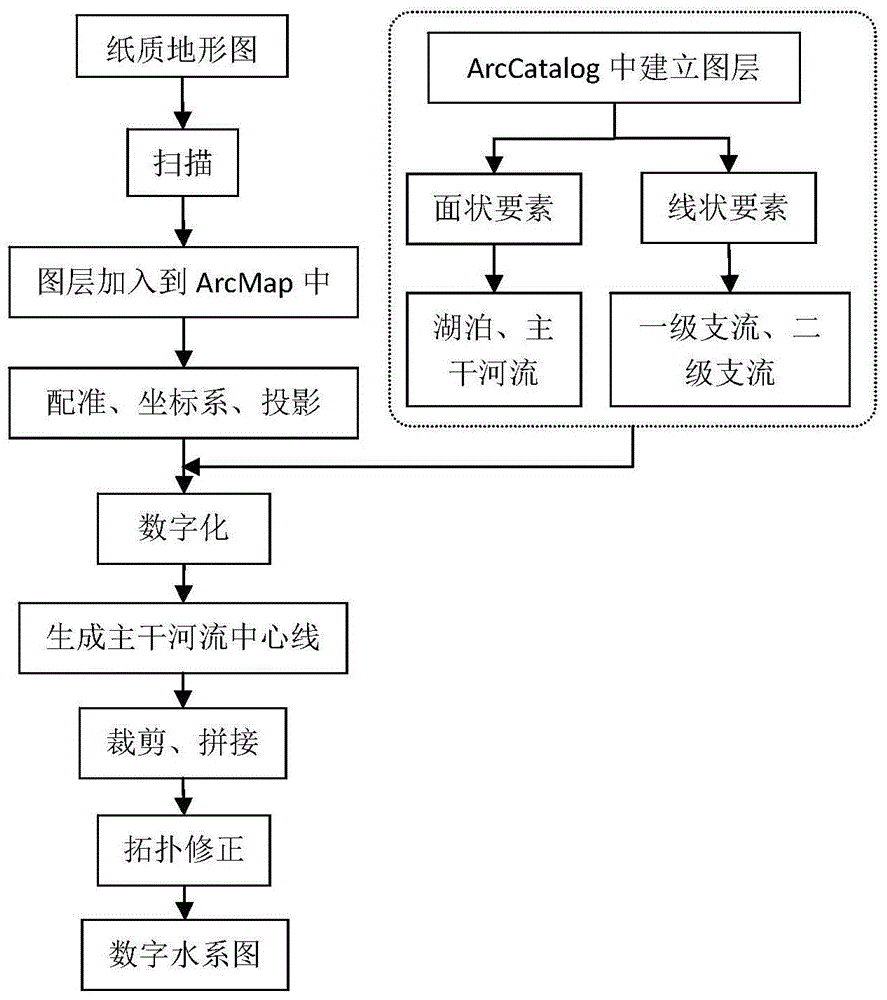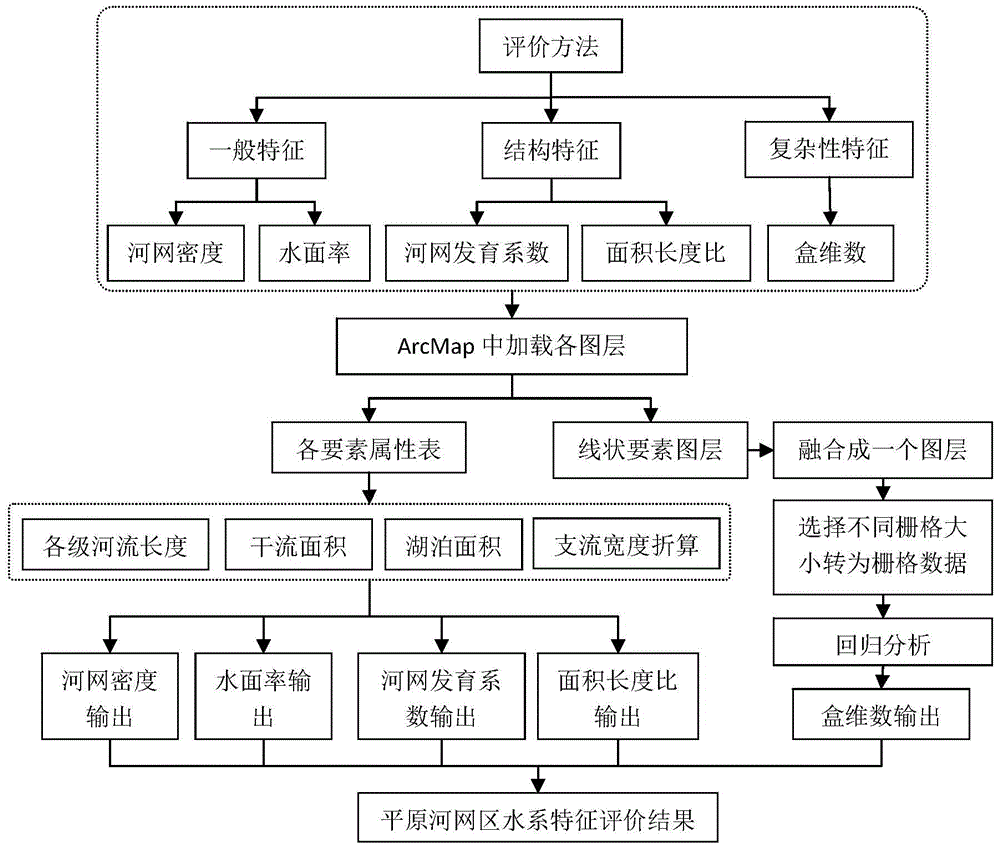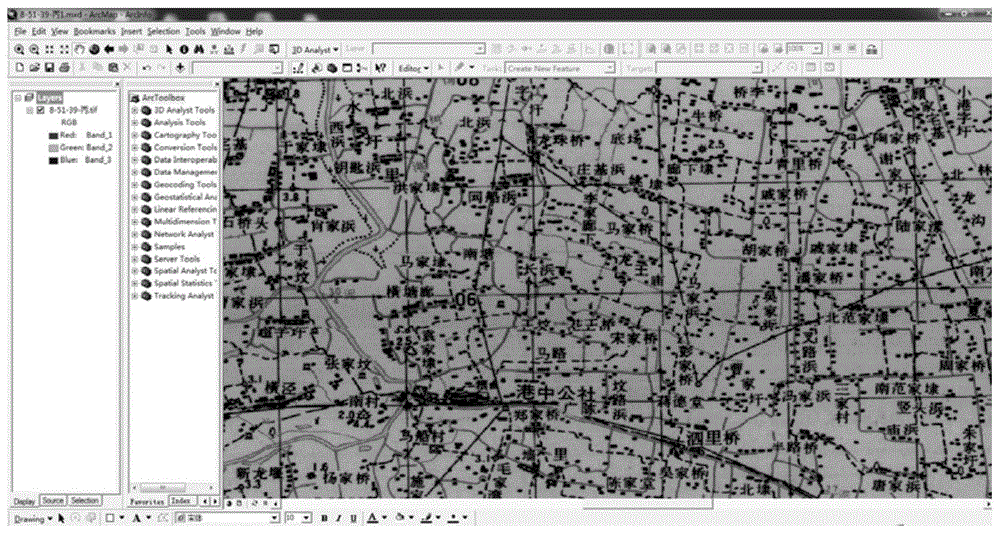Plain area water system characteristic evaluation method based on ArcGIS (Geographic Information System)
A feature evaluation, water system technology, applied in the direction of instrument, data processing application, calculation, etc., can solve the problems of low index efficiency and need further theoretical analysis and practical verification.
- Summary
- Abstract
- Description
- Claims
- Application Information
AI Technical Summary
Problems solved by technology
Method used
Image
Examples
Embodiment 1
[0039] An ArcGIS-based evaluation method for water system characteristics in plain areas, the steps are:
[0040] (A) Acquisition of river network data in the study area
[0041] A1, scanning and registration. The 1:50,000 topographic map of the study area was scanned with an accuracy greater than 300dpi. Load the scanned map in ArcMap, set the layer display to degrees (DegreesDecimalMinutes), register according to the coordinates on the topographic map, and export (rectify) it into a tiff map. Set the coordinate system and projection of the map in ArcCatalog. According to the location of the study area and the time when the topographic map was formed, the coordinate system is Beijing 1954, and the projection is Gauss-Krüger projection 6-degree zone 21 (Beijing1954GKZone21N.prj).
[0042] A2. Create layers. In ArcCatalog, establish two vector layers of linear features of primary tributaries (layer ①) and secondary tributaries (layer ②), and two surface features of main rive...
Embodiment 2
[0071] Taking the 1960s Fifty Thousand topographic map of the Hangjiahu area in the Taihu Lake Basin as an example, the Hangjiahu Plain is located in the south of the Taihu Lake Basin, with an area of about 7607km 2 . The rivers in the area are criss-crossed, belonging to a typical plain area, with a river network density of 2.3km / km 2 , The water surface rate is about 8.6%. Scan and register the 1:50,000 paper topographic map of the Hangjiahu area in the 1960s (see image 3 topographic map of the study area), digitized (see Figure 4 digitization of topographic maps), topology inspection, splicing and cropping, etc., to obtain water system maps (see Figure 5 water system map of the study area). Table 1 is the classification of river systems and rivers in the plain river network area of the present invention. Table 2 is the water system structure index parameter system of the present invention. The following table 1 is the water system classification in the plain ar...
Embodiment 3
[0077] The lack of digital topographic maps before 2000 is not conducive to the analysis of water system characteristics. The invention is based on the ArcGIS technology, adopts a simple method to extract the water system data of the topographic map, and is convenient for implementation and operation.
[0078] The present invention characterizes the water system characteristics of the plain river network area through 3 categories and 5 items of indicators, and the water system indicators are independent of each other. . Among them, the ratio of area to length is a new index of the present invention. Compared with the previous complicated and repeated indexes, the evaluation method of the present invention is more systematic and scientific. And the method is simple to operate and easy to promote to other regions. Table 3 shows the advantages of the index parameter system of the present invention.
[0079] table 3
[0080]
[0081]
PUM
 Login to View More
Login to View More Abstract
Description
Claims
Application Information
 Login to View More
Login to View More - R&D
- Intellectual Property
- Life Sciences
- Materials
- Tech Scout
- Unparalleled Data Quality
- Higher Quality Content
- 60% Fewer Hallucinations
Browse by: Latest US Patents, China's latest patents, Technical Efficacy Thesaurus, Application Domain, Technology Topic, Popular Technical Reports.
© 2025 PatSnap. All rights reserved.Legal|Privacy policy|Modern Slavery Act Transparency Statement|Sitemap|About US| Contact US: help@patsnap.com



